GALAPAGOS OF THE SOUTHERN OCEAN
__________________
__________________
| Day | Place | Highlights |
|---|---|---|
| Day 1 | Hobart | Guests should make their way to the designated hotel. |
| Day 2 | Port of Hobart | Departing for the Port of Hobart to embark your ship. |
| Days 3 - 4 | At Sea | Wandering Albatross, Royal Albatross, Black-browed Albatross, Light-mantled Sooty Albatross, Salvin’s Albatross and Grey-headed Albatross. |
| Days 5 - 6 | Macquarie Island | See the Royal Penguin, along with King, Gentoo and Rock Hopper Penguins & Elephant Seals |
| Day 7 | At Sea | Look for cetaceans, albatross & petrels |
| Days 8 - 9 | Campbell Island | Perseverance Harbour |
| Day 10 | Auckland Islands | Carnley Harbour |
| Day 11 | Auckland Islands | Enderby Island |
| Day 12 | The Snares - North East Island | Search for Snares Crested Penguin and Buller's Albatross |
| Day 13 | Invercargill/Queenstown, New Zealand | Disembark at the Port of Bluff early in the morning |
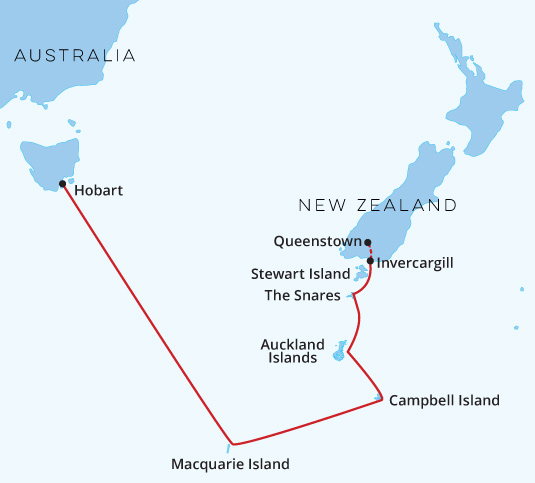
Heritage Adventurer
The Heritage Adventurer (formerly the MS Hanseatic) is a modern, ice-strengthened Antarctic cruise ship with all en-suite cabins accommodating up to 146 guests. Purpose built for polar waters in Rauma Finland, the Heritage Adventurer not only has the highest ice class rating (Lloyds 1AS) she also offers unmatched stability and superior speed to get you to your destination and out exploring.
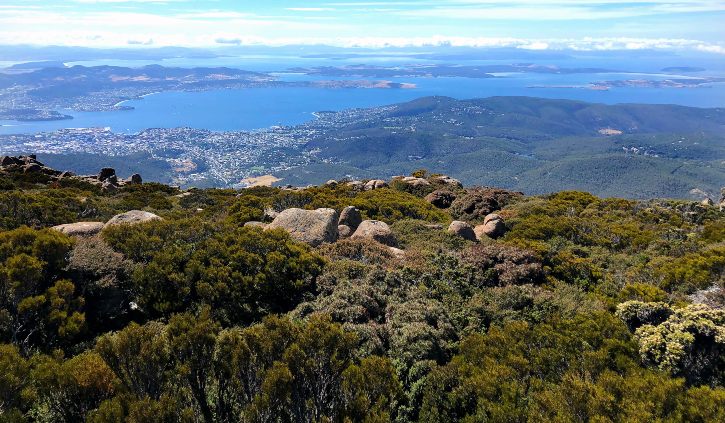
Arrive in Hobart, capital of Australia’s Island state of Tasmania and make your way to the designated hotel where you will spend the first night of the expedition. This bustling port town is rich in culture and colonial history, and features a renowned foodie scene all wrapped in stunning waterfront surrounds. This evening there will be an informal get-together at the hotel for dinner; an excellent opportunity to meet fellow adventurers on your voyage and some of the expedition team.
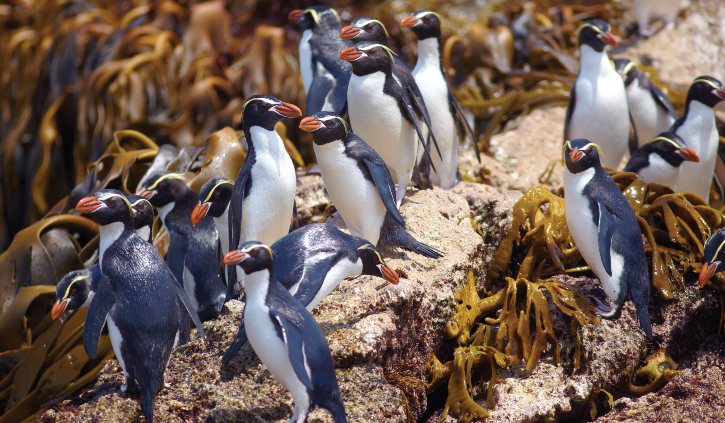
Today, enjoy breakfast in the hotel restaurant before departing for the Port of Hobart to embark your ship. You will have time to settle into your cabin and familiarise yourself with the ship. Early afternoon, you will depart the Port of Hobart, the centre for the Southern Ocean whaling and sealing trade; it is now a busy seaport and also serves as the home port for both Australian and French Antarctic operations. You are invited to join the expedition team in the Observation Lounge and up on the Observation Deck as you sail across Storm Bay. Sail past Bruny Island and the Tasman Peninsula and set course for Macquarie Island.
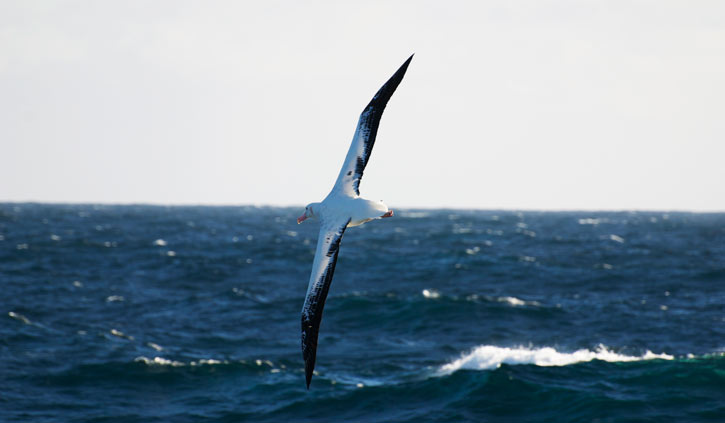
As you make your way south through the Roaring Forties to Macquaire Island, you will prepare for your visit, and there will be a series of lectures on the biology and history of the island and the Southern Ocean. Birding opportunities may include the Wandering Albatross, Royal Albatross, Black-browed Albatross, Light-mantled Sooty Albatross, Salvin’s Albatross, Grey-headed Albatross, Northern and Southern Giant Petrel, Sooty Shearwater and Little Shearwater. Other species to be on the lookout for include the Soft-plumaged Petrel, Mottled Petrel, White-headed Petrel, Greyfaced Petrel, White-chinned Petrel, Grey-backed Storm-petrel, Wilson’s Storm-petrel, Black-bellied Stormpetrel and Common Diving-petrel.
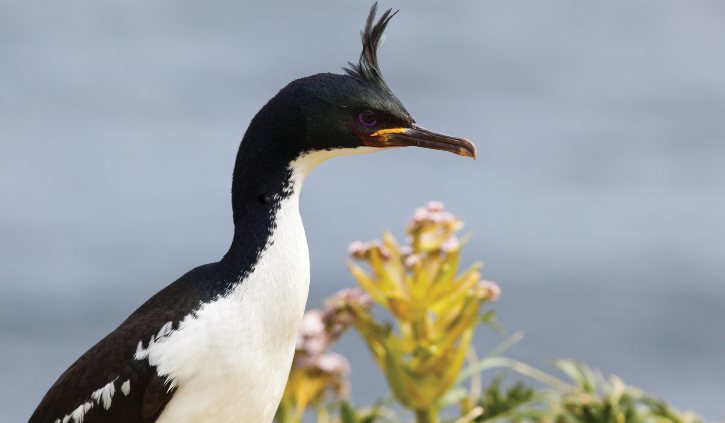
The great Australian Antarctic Explorer Sir Douglas Mawson once called Macquarie Island “One of the wonder spots of the world”. You are about to discover why, as you spend two days exploring this amazing Island. It was one of the first of the Subantarctic Islands to obtain World Heritage Status and that was largely due to its unique geology. It is one of the few places on earth where midocean crustal rocks are exposed at the surface due to the collision of the Australian and Pacific Plates.
“Macca”, as it is affectionately known by its resident ranger population, was discovered in 1810 and was soon ravaged by sealers who introduced various animals including rats, mice, cats and rabbits. The native bird population was virtually eliminated and plants destroyed. The Tasmanian National Parks and Wildlife Service, who administer the island, embarked on a very ambitious 7-year eradication program resulting in the island earning pest-free status in 2014. Both the birds and plants have responded and it is amazing to witness the regeneration and the increase in the number of birds.
Macquarie Island is home to four species of penguin, Kings, Royals, Gentoo and Rockhopper, with the Royal Penguin occurring nowhere else in the world. During your visit, you will land at two sites (subject to weather and sea conditions) and you will get a chance to observe and photograph all four
species. Macquarie also has a large population of Southern Elephant Seals. Pups are born in October and weaned in November when the breeding adults return to sea. The weaners and sub adults lie around on the beaches. The weaners go to sea sometime in January, running the gauntlet of Orcas or Killer
Whales waiting offshore. Macquarie Island is also home to one of the longest, continuously occupied bases in the Subantarctic – the Australian Antarctic Research Base at Buckles Bay. The original base was established in 1947 and the island has been ‘manned’ since then.
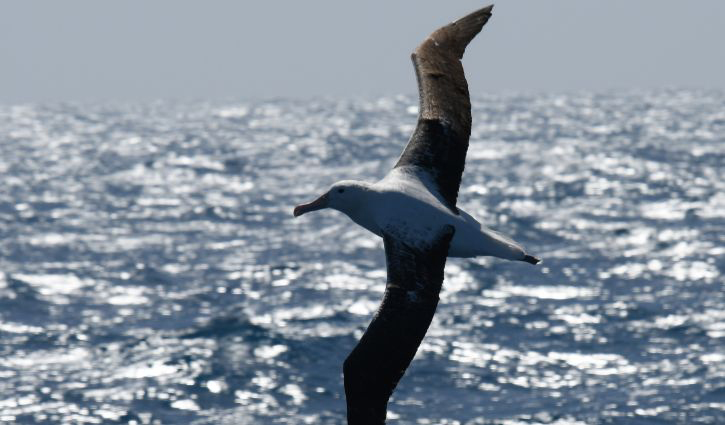
Sailing east through the Furious Fifties, also known as the Albatross latitudes, there will be a series of informal lectures on the biology and history of the Subantarctic Islands and prepare for your visit to Campbell Island. Species that you may see include the Wandering Albatross, Royal Albatross, Black-browed Albatross, Light-mantled Sooty Albatross, Salvin’s Albatross, Grey-headed Albatross, Northern and Southern Giant Petrel. There should be plenty of prions including Fairy, Fulmar and Antarctic, identifying them is not easy – but you should get some great views.
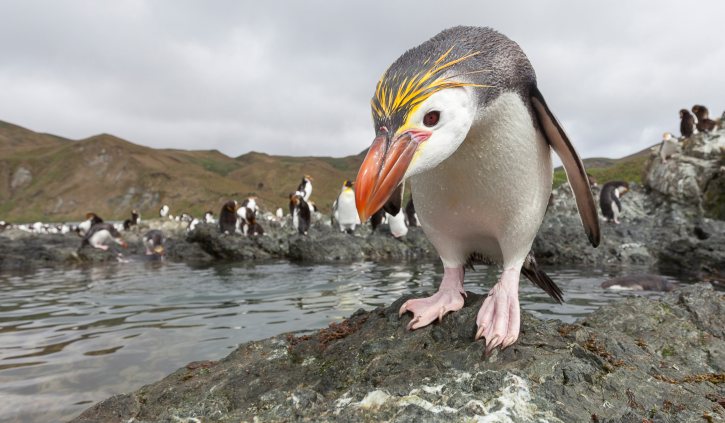
You have two days to explore Campbell Island, New Zealand’s southernmost Subantarctic territory. Its history is as rich and varied as the other islands you will have visited. Discovered in 1810 (by the same sealing captain who discovered Macquarie Island) it too was soon occupied by sealers who introduced rats and cats. In 1895, the New Zealand government advertised the island as a pastoral lease. The lease was taken up by an entrepreneurial New Zealand sheep farmer who stocked the island with sheep and cattle. The farming practices, which included burning the scrub, modified the island considerably. The farming lasted until 1934 when it was abandoned. Coastwatchers were stationed on the island during the war, at the end of the war the station was taken over by the New Zealand Meteorological service and they maintained a manned weather/research station on the island until 1995.
In the early 1970s the island was fenced in half and stock was removed off the northern half. The impacts of the remaining animals were monitored and they were all eventually removed in 1990. The vegetation recovered quickly and the cats died out naturally. With the island declared predator free in 2003, the way was clear to reintroduce the endangered Campbell Island Flightless Teal, which had been rediscovered on an offshore island in 1975. Snipe, which were formerly unknown from the island but were discovered on another offshore island, recolonised the islands themselves. The vegetation which the great English botanist Sir Joseph Hooker described in 1841 as having a “Flora display second to none outside the tropics” is flourishing and is nothing short of spectacular.
A number of options to explore the island are offered. There will be extended walks to Northwest Bay and also an easier walk to the Col Lyall Saddle. All of these options will allow you the opportunity and time to enjoy the Southern Royal Albatross which nest here in large numbers. You will also visit areas of the island which contain outstanding examples of the mega-herbs for which the island is renowned.
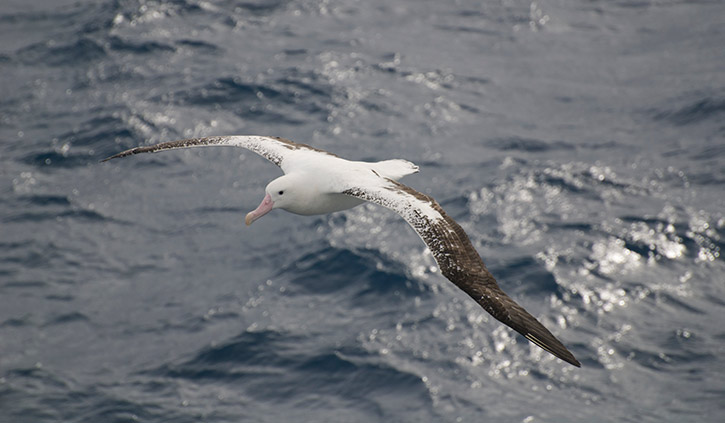
The Auckland Islands group was formed by two volcanoes which erupted some 10-25 million years ago. They have subsequently been eroded and dissected by glaciation creating the archipelago as we know it today. In the south of the archipelago there is a very large sheltered harbour rich in human history including shipwrecks, treasure hunters, Coastwatchers and, of course, scientific parties. You will enter the harbour through the eastern entrance which is guarded on both sides by dramatic cliffs and rugged, tussock-covered hills.
The more energetic expeditioners may climb to the South West Cape and visit the Shy Albatross colony. This climb provides magnificent views in all directions, especially over the western entrance to Carnley Harbour, Adams Island and Western Harbour. For those not climbing there will be an opportunity to Zodiac cruise along the coast of Adams Island and Western Harbour, with landings at the latter. Other options include the Tagua Bay Coastwatcher’s hut and lookout which was occupied during the Second World War. You could visit Epigwatt and the remains of the ‘Grafton’ which was wrecked here in 1864. All five men aboard survived and lived here for 18 months before sailing their modified dinghy to New Zealand to get help.
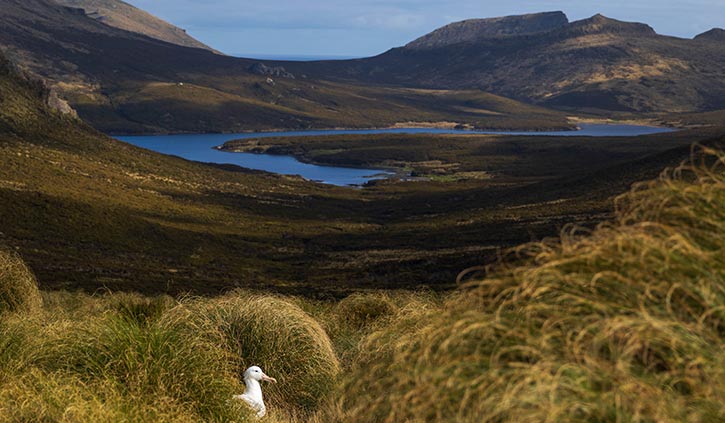
Enderby Island is one of the most beautiful islands in this group and is named after the same distinguished shipping family as one of our former vessels. This northern most island in the archipelago is an outstanding wildlife and birding location and is relatively easy to land on and walk around. The island was cleared of all introduced animals (pests) in 1994 and both birds and the vegetation, especially the herbaceous plants, are recovering both in numbers and diversity. The plan is to land at Sandy Bay, one of three breeding areas in the Auckland Islands for the Hooker’s or New Zealand Sea Lion, a rare member of the seal family. Beachmaster bulls gather on the beach, defending their harems. Hooker’s or New Zealand Sea Lion numbers are in a slow decline, for reasons which are not obvious but most probably connected with a nearby squid fishery. During your day ashore there will be several options, some longer walks, some shorter walks and time to spend just sitting and enjoying the wildlife. The walking is relatively easy, a boardwalk traverses the island to the dramatic western cliffs, from there you will follow the coast and circumnavigate the island. Birds that we are likely to encounter include the following species: Southern Royal Albatross, Northern Giant Petrel, Auckland Island Shag, Auckland Island Flightless Teal, Auckland Island Banded Dotterel, Auckland Island Tomtit, Bellbird, Pipit, Red-crowned Parakeet, Yelloweyed Penguin and Light-mantled Sooty Albatross. There is also a very good chance of observing the Subantarctic Snipe.
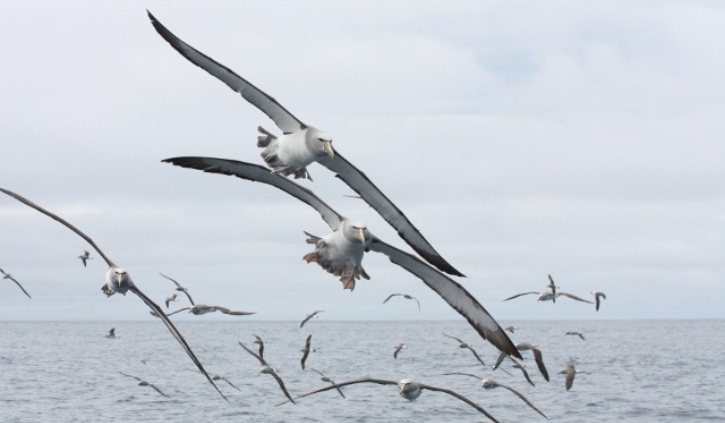
The closest Subantarctic Islands to New Zealand, they were appropriately called The Snares as they were once considered a hazard for sailing ships. Comprising of two main islands and a group of five islands called the Western
Chain; they are uninhabited and enjoy the highest protection as Nature Reserves. It is claimed by some that these islands are home to more nesting seabirds than all of the British Isles together. Plan to arrive early in the morning and, as landings are not permitted, you will Zodiac cruise along the sheltered eastern side of the main island if the weather and sea conditions are suitable. In the sheltered bays, you should see the endemic Snares Crested Penguin, Snares Island Tomtit and Fernbirds. Cape Pigeons, Antarctic Terns, White-fronted Terns and Red-billed Gulls are also present in good numbers. There are hundreds of thousands of Sooty Shearwaters nesting on The Snares; the actual number is much debated. This afternoon en route to the Port of Bluff, take the opportunity to relax and reflect on an amazing experience. You will recap the highlights of your expedition and enjoy a farewell dinner tonight as you complete the last few miles of your journey.
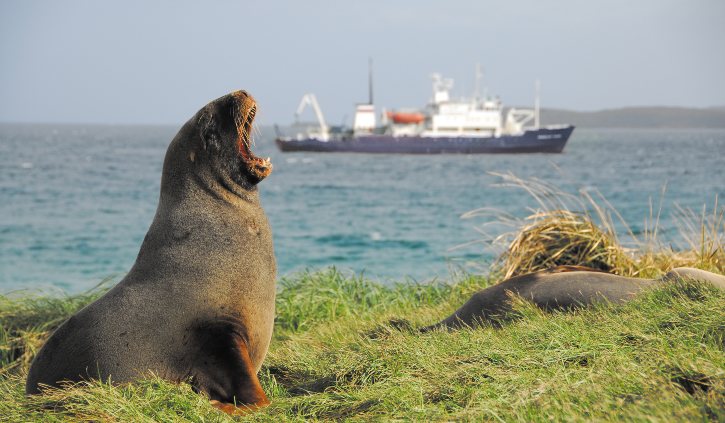
Early this morning you will arrive in the Port of Bluff. After a final breakfast, you will bid farewell to your fellow voyagers and take a complimentary coach transfer to either Invercargill or Queenstown Airports. In case of unexpected delays due to weather and/or port operations, it is asked that you do not to book any onward travel until after midday from Invercargill and after 3pm from Queenstown.